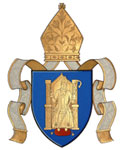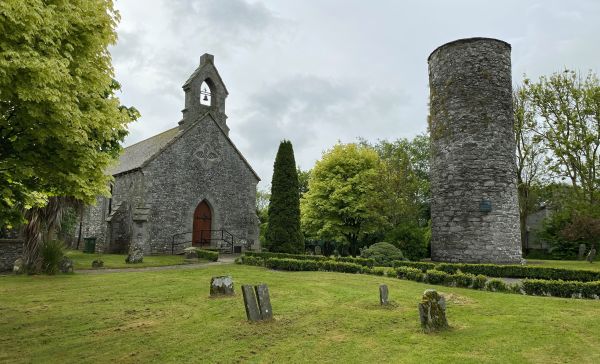 |
 |
News
Ecumenical Service for Pentecost to take place at Inniskeen, Co. Monaghan

The church and round tower at Inniskeen.
The Ecumenical Service for Pentecost Sunday in Clogher Diocese will take place this year at the former Church of Ireland church, graveyard and ancient round tower at Inniskeen near Carrickmacross, Co. Monaghan.
Both the Roman Catholic Bishop of Clogher, the Most Revd Larry Duffy and the Church of Ireland Bishop of Clogher, the Right Revd Dr. Ian Ellis, will lead the service which begins at 4pm on Sunday, 28 May.
Bishop Larry Duffy will give the address at this service. Local clergy from parishes in the Carrickmacross area; Revd Ian Cruickshank, Rector of Carrickmacross Union, Magheracloone and Ardragh and Canon Martin Treanor, P.P., Inniskeen Parish, will also be taking part.
During the service, two young people from post-primary schools in the area will be giving reflections on Pentecost. The praise will be led by local singers accompanied on the keyboard.
Afterwards, refreshments will be provided in the local community centre.
Since 2000, the Roman Catholic and Church or Ireland bishops of Clogher have come together, along with members of their respective Church communities to mark together the Day of Pentecost or Pentecost Sunday, as it also known. The Day of Pentecost marks the end of the fifty-day season of Easter. Moreover, it marks the descent of the Holy Spirit in the upper room and the beginning of apostolic preaching, thus marking a defining moment in the origin of the Christian Church. Christian associations with the feast begin with Acts of the Apostles 2: 1-45.
Each year, a site of historic significance in relation to the origins of the Christian church in different parts of the diocese is chosen to host this ecumenical service.
This year’s outdoor service takes place at the monastic site at Inniskeen where St. Daigh lived towards the end of the 6th Century. According to tradition he was born in Kiennacta Breagh, near Duleek in the east of the kingdom of Meath and was a brother of St Felim, later to be Bishop of Kilmore. Daigh was styled a bishop of the Irish monastic tradition, referred to in the Martyrology of Donegal as ‘Bishop of Inis-Caoin-Degha in Conaille Muirtheimhne’. The 16th century collection of documents known as the Register of Clogher, lists him among the early successors of St Macartan. He was baptised by St Molaise (also known as Laserian) at the Augustinian priory of canons regular at Devenish on Lough Erne in Fermanagh and educated there as well as at Bangor. Pádraig Ríain tells us that ‘Mochta, patron of the Augustinian priory of Louth, one of the richest of its kind, is shown in an extensive introductory section [of the life of Daigh] to have recognised Daigh’s future sanctity and to have foretold the affiliation of Iniskeen to Clonmacnoise.’ This life of Daigh was probably written at Clonmacnoise in the mid-to-late twelfth century. It was at Clonmacnoise that he was probably ordained to the priesthood before coming to the banks of the Fane to found, with the blessing of St Columba, the monastic settlement of Inis Caoin Deagha sometime around 562. Daigh was a noted craftsman and is reputed to have fashioned numerous bells, shrines, reliquaries, crosses and covers for the Book of the Gospels.
St Daigh would also have travelled to different parts of Ireland, notably through north Connacht and other parts of Ulster, and his name is associated with a variety of church communities in the martyrologies of saints.
St Daigh’s date of death is listed as either the 16 or 18 August 588.
The monastery at Inniskeen was burned in 789, plundered by the Vikings in 948 and burned again in 1166, just before the Norman invasion of Ireland, which would lead to much change. With the passage of time, the monks were replaced by secular clergy.
Today, all that is left of the monastic foundation is the Church of Ireland church (closed in 1970), which contains remnants of the earlier foundation, and the bottom part of the round tower. For many years afterwards, Inniskeen parish was (and still is, officially) known as the Parish of Inis-Caoin-Deagha.
Directions: From Carrickmacross (on the N2) take the R178 (Dundalk) road. At Essexford take the L4620 to Inniskeen village. The church and round tower are just to the left off the centre of the village. It’s about 15 minutes (17kms) from the N2 at Carrickmacross to Inniskeen.